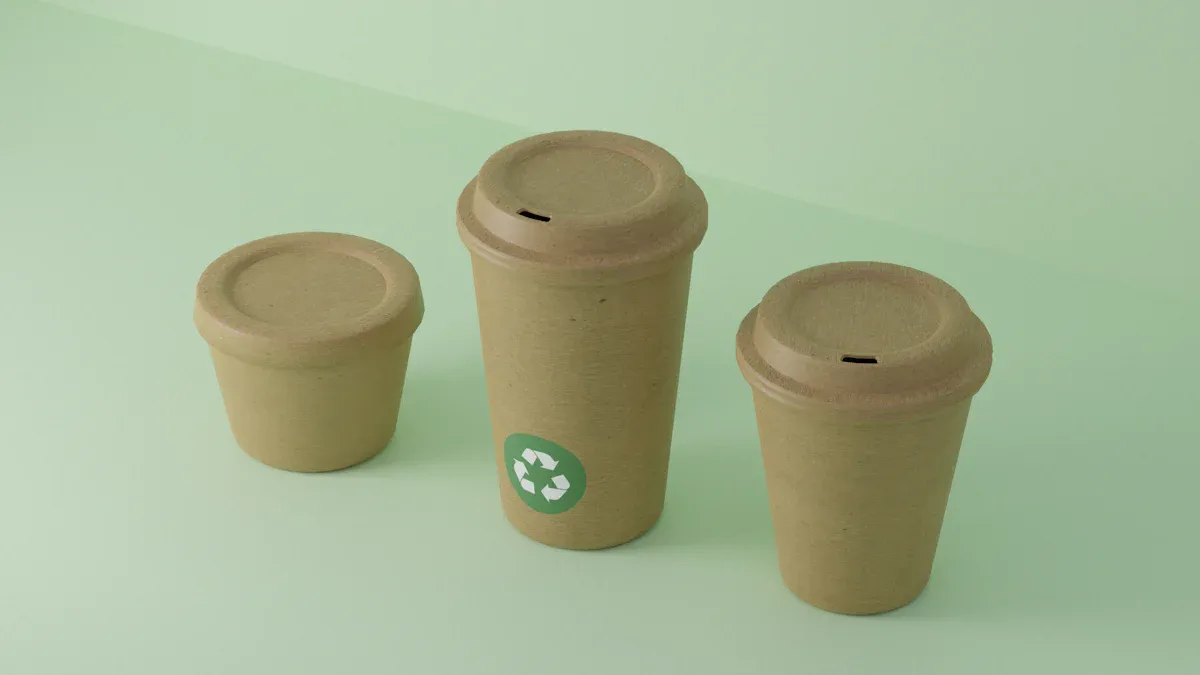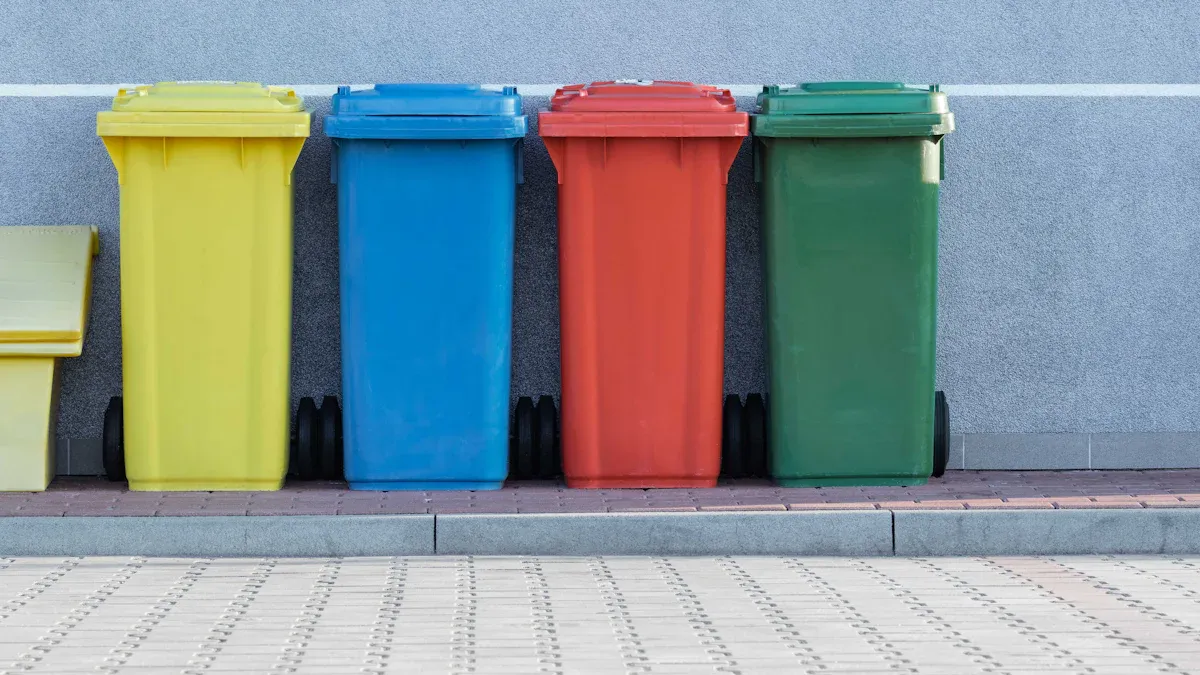You can recycle, compost, or throw away disposable paper bowls. The right choice depends on the bowl type and local rules. Always look for labels or symbols on your bowls. Some guides explain why recycling is important by showing these differences. If you want the best results, follow easy steps and listen to local instructions. Remember, small actions are important.
Tip: Sorting disposable paper bowls the right way helps the environment and supports your community’s recycling.
Key Takeaways
-
Look at the labels on your paper bowls. This helps you know if they can be composted, recycled, or must go in the trash. Always take out leftover food from the bowls. Rinse the bowls before you recycle or compost them. This keeps the process clean and works better. Plain paper bowls without plastic can often be recycled. Compostable bowls should go in compost bins if your city takes them. Bowls with plastic coatings usually cannot be recycled or composted. These bowls need to go in the trash. Always follow your local recycling and composting rules. This helps protect the environment and your community.
Types of Disposable Paper Bowls

Compostable Bowls
Compostable bowls often have words like “compostable” or a leaf symbol. These bowls break down at special compost places. Look for certifications like “BPI Certified Compostable” or “OK Compost.” These labels show the bowl will turn into soil at a compost site. Most compostable bowls use plant-based materials or compostable plastic. You cannot compost these bowls at home unless the label says “home compostable.” Always check if your local compost place takes these bowls.
Tip: Compostable bowls help keep trash out of landfills when you use the right compost system.
Recyclable Bowls
Some disposable paper bowls are recyclable. You can find them by looking for the recycling symbol (♻️) or the words “recyclable paper.” These bowls do not have plastic coatings. Rinse them before putting them in your recycling bin. If your bowl feels waxy or shiny, it might not be recyclable. Recycling centers do not take bowls with food left on them or with plastic linings. Always check your city’s recycling rules to sort them the right way.
Plastic-Coated Bowls
Many disposable paper bowls have a thin plastic coating inside. This coating stops liquids from leaking through. Most companies use low-density polyethylene or compostable plastic like PLA. These coatings make recycling hard. Most recycling centers cannot take plastic-coated bowls. Composting is also hard with these bowls. Only a few big compost sites take bowls with compostable plastic linings. Home compost bins cannot break down these coatings. Because of this, you usually need to throw these bowls in the trash.
Note: Most disposable paper bowls have plastic coatings, just like many paper cups. This makes both recycling and composting much harder.
Reading Labels
Always read the labels on your disposable paper bowls. Look for words like “compostable,” “recyclable,” or “biodegradable.” Symbols like the recycling triangle or a compost leaf help you sort your bowls. Some packages say “biodegradable paper food packaging.” This means the bowl will break down over time, but not always in a home compost bin. If you see “compostable plastic,” check if it is for home or industrial compost. If you are not sure, check your local recycling or compost guide.
-
Quick Label Guide Table:
|
Label/Symbol |
What It Means |
Where to Dispose |
|---|---|---|
|
♻️ Recyclable |
No plastic coating |
Recycling bin |
|
🌱 Compostable |
Plant-based or compostable plastic |
Industrial compost |
|
Breaks down over time |
Check local rules |
|
|
Plastic-Coated |
Thin plastic lining |
Usually trash |
Sorting and Cleaning Steps
Remove Food Waste
Start by scraping all leftover food from your disposable paper bowls. Food can ruin the recycling process. If you plan to compost, make sure you remove any large food pieces. This step helps keep recycling bins clean and makes compost work better. You can use a napkin or spoon to get rid of sticky bits.
Tip: Bowls with food still on them often end up in the trash instead of recycling or compost.
Rinse and Clean
After you remove food, rinse the bowl with a little water. Clean bowls help the recycling process run smoothly. If you want to compost, a quick rinse removes sauces or oils that slow down compost. Let the bowl dry before you sort it. You do not need to scrub hard, just make sure no food sticks to the surface.
Separate Materials
Some bowls have a plastic coating or extra layers. Try to peel off any plastic film if you can. Most recycling centers do not accept bowls with plastic linings. If you cannot separate the layers, check the label. Bowls with plastic coatings usually go in the trash. Only put plain paper bowls in the recycling bin. Compostable bowls should go to a compost facility.
-
Quick Sorting Table:
|
Bowl Type |
Next Step |
Final Bin |
|---|---|---|
|
Plain Paper |
Rinse, dry |
Recycling |
|
Compostable |
Rinse, dry |
Compost |
|
Plastic-Coated |
Remove plastic if possible |
Trash |
Sorting for Compost, Recycling, or Trash
Now you can sort your bowls. Place clean, plain paper bowls in the recycling bin. Put compostable bowls in the compost bin if your city accepts them. Bowls with plastic coatings usually belong in the trash. Always check your local rules for proper disposal methods. This step-by-step guide to recycling helps you make the right choice every time. When you follow these steps, you support the recycling process and help the environment.
Remember: Recycling and compost both work best when you sort and clean your bowls first.
Recycling and Composting Rules

Check Local Guidelines
Always check your city’s recycling rules before sorting bowls. Each city or office can have different rules. Some places let you put compostable bowls in curbside compost bins. Other places do not allow this. You can find these rules on your city’s website. You can also call your waste office for help. Many cities change their rules every year. Check for new rules in 2025. If you live in an apartment or work in an office, ask your building manager about recycling and compost.
Tip: Keep your city’s recycling rules on your phone or print them out. This makes it easy to check them.
Common Disposal Options
Most places give you a few ways to throw away disposable paper bowls. Here are some common choices:
-
Recycling bin: Put clean, plain paper bowls in the recycling bin if your city takes them.
-
Compost bin: Put compostable bowls in the compost bin if your city has curbside compost or a drop-off spot.
-
Trash: Throw away plastic-coated or dirty bowls if your city does not recycle them.
Always rinse bowls before putting them in recycling. Recycling centers do not take bowls with food or plastic coatings. Compostable bowls go in compost only if the label and city rules say so.
|
Disposal Option |
Accepted Bowls |
Not Accepted |
|---|---|---|
|
Recycling |
Clean, plain paper |
Plastic-coated, dirty |
|
Compost |
Certified compostable |
Non-compostable, plastic |
|
Trash |
Plastic-coated, dirty |
Clean, plain paper, compostable |
If Unsure, What to Do
If you are not sure how to throw away a bowl, follow these steps:
-
Look for recycling or compost labels on the bowl.
-
Check your city’s recycling rules.
-
If you still do not know, put the bowl in the trash. This stops recycling from getting mixed up.
-
Ask your city or recycling center for help if you need it.
Remember: Recycling works best when everyone follows the rules. You help your community by sorting bowls the right way.
Eco-Friendly Tips
Proper Disposal Practices
You can help the planet by throwing away bowls the right way. Always look at the label before tossing a bowl. If the bowl is clean and says recyclable, put it in your recycling bin. Compostable bowls should go to a compost place if your city takes them. Bowls with plastic coatings usually go in the trash. Sorting your waste the right way helps the earth. Clean bowls before you throw them out. This keeps recycling centers working well.
Tip: If you keep food out of recycling bins, your community can recycle more and waste less.
Choose Certified Eco-Friendly Products
When you buy disposable paper bowls, look for eco-friendly labels. Pick bowls that are certified compostable or recyclable. Some bowls say biodegradable, but not all break down fast or safely. Certified products help the planet and lower harm to nature. You can also look for labels like “BPI Certified Compostable” or “FSC Certified Paper.” These show the product meets strong environmental rules.
-
Eco-Friendly Product Checklist:
-
Certified compostable or recyclable
-
No plastic coating
-
Made from renewable materials
-
Clear disposal instructions
-
Share with Others
You can teach friends and family about recycling and being green. Share tips on reading labels and sorting bowls the right way. Talk about how using the right products and sorting waste helps the earth. You could even start a recycling challenge at school or in your neighborhood. When more people know how to sort and throw away bowls, everyone benefits.
Remember: Every small action helps make the world cleaner and greener.
You can sort disposable paper bowls by checking the labels. Take off any food before you throw them away. Always follow your city’s rules for recycling or composting. Read your local guidelines before you recycle or compost anything. Small changes in what you do every day help the earth. When you make good choices, other people want to help too. 🌎
FAQ
Can you recycle all paper bowls?
No, you cannot recycle all paper bowls. Only plain paper bowls without plastic coatings go in the recycling bin. Always check for recycling symbols or labels before you sort your bowl.
What do you do if your bowl has food stains?
You should scrape off all food and rinse the bowl. If stains remain, check your local rules. Some places accept lightly stained bowls for compost. Most recycling centers do not take dirty bowls.
How do you know if a bowl is compostable?
Look for words like “compostable” or a leaf symbol on the bowl or packaging. Certified compostable bowls often have “BPI Certified” or “OK Compost” labels. If you do not see these, the bowl is likely not compostable.
What happens if you put the wrong bowl in recycling?
Recycling centers may throw away the whole batch if you mix in the wrong items. Always sort carefully. You help the recycling process work better when you follow the rules.





